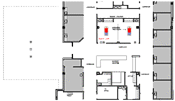In the search to develop solid, credible, evidence-based answers to complex questions during an emerging global pandemic, simulation modeling has stepped up to the challenge. More than ever before, governments and healthcare care systems worldwide are relying on simulation to help guide critical decisions.
In response to COVID-19 and other pandemics, a collaboration between George Mason University, The World Bank, and Johns Hopkins University have developed a portal that supports Models for Assessing Strategies for Hospitals (MASH). MASH-Pandemics ExtendSim models can be used for a range of what-if analyses for hospitals and groups of hospitals. They help provide recommendations under realistic operating conditions, including the COVID-19 outbreak. The models quantify the potential benefits of increasing hospital capacity by applying different strategies, changing how staffing and inventory are managed, adjusting how patients are triaged when they arrive, and taking other adaptive measures.
How effective are formalized collaboration strategies when responding to a pandemic or disaster incident involving mass casualties and area-wide damage? How best can patients be transferred and resources, including staff, equipment and supplies, be shared across hospitals? ExtendSim was used to help quantify hospital system resilience to pandemic, MCI, and disaster events with damage. Patient flows through 9 critical units of multiple hospitals spaced over a large metropolitan region were analyzed to determine impacts on critical resources, physical spaces, and demand. Hospital resilience to these hazard events was evaluated to show the potential of strategies involving not only transfers and resource sharing, but also joint capacity enhancement alternatives to improve emergency health care service delivery through joint action.
The CDC's National Center for Immunization & Respiratory Diseases spearheaded a study in conjunction with Battelle and other entities, 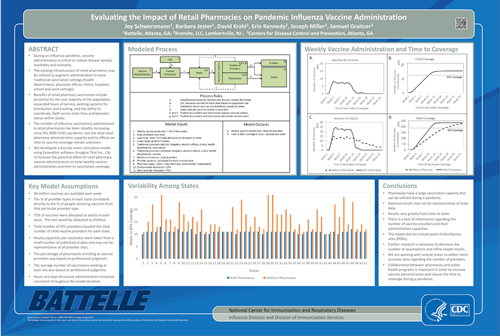 to quantify the potential of integrating retail pharmacies into pandemic vaccine response planning. The ExtendSim model created indicated the weekly national vaccine administration capacity increased to 25 million doses per week supporting efforts to achieve a projected 80% vaccination coverage of a single dose of vaccine per person when retail pharmacies are integrated into pandemic vaccine response planning. Details of this study was published in the February 2017 Disaster Medicine and Public Health Preparedness Journal.
to quantify the potential of integrating retail pharmacies into pandemic vaccine response planning. The ExtendSim model created indicated the weekly national vaccine administration capacity increased to 25 million doses per week supporting efforts to achieve a projected 80% vaccination coverage of a single dose of vaccine per person when retail pharmacies are integrated into pandemic vaccine response planning. Details of this study was published in the February 2017 Disaster Medicine and Public Health Preparedness Journal. 
As shelter in place regulations slowly lift, how can we best manage the reopening of public spaces to maintain a high quality visitor experience while adhering to social distancing requirements? For close to 2 decades, ExtendSim has been used by the National Park Service to model visitor use in iconic national parks: such as Yosemite, Mount Rainier, Isle Royale, and Rocky Mountain National Parks, Muir Woods National Monument, and the Inyo National Forest. These simulation models have established a basis for visitor use management decision making through examining and simulating relationships between visitor use levels and variables relevant to visitor experience and management operations. The investigation published in Park Science magazine addressing park crowding through scientifically defensible means, a practice now prudent in high-visibility parks and other public spaces.
ExtendSim Dynamic Simulation Models Can...
 Accurately determine what the demand will be on hospital resources such as doctors, nurses, beds, rooms, equipment, and emergency transport vehicles.
Accurately determine what the demand will be on hospital resources such as doctors, nurses, beds, rooms, equipment, and emergency transport vehicles.- Guide decisions to help quickly adjust to new protocols.
- Determine the ability of these resources and systems to provide the level of care required for patients who have contracted COVID-19.
- Predict how these systems will perform over time subject to varying rates of COVID-19 cases requiring medical treatment and support.
- Help understand the potential trajectory of a pandemic.
- Unlock the best possible decisions given the fluidity of pandemics to provide lots of great insights on what to do and not do.
ExtendSim Use in Related Situations
- Demand and capacity planning for an Intensive Care Unit examined patient flow pathways in a care unit (Definite MI, Suspected MI, LVF, and Arrhythmia) to investigate the impact of bed blockages in the medical ward on the ability of the unit to deliver its specialized care.
- Resource prioritization and allocation in the short and long term when faced with projected increases in clients and the need to expand without over-expanding.
 Modeling perioperative systems in a hospital - Utilizing data from a study containing a large dataset (90,000+ records of 30,000+ patients) culled from hospital patient logs and electronic data collection systems, ExtendSim was used to evaluate alternate process flows, policies, staffing, and resource allocation, for the cases flowing through a renovated space. This level of fidelity increased team buy-in and increased certainty that savings estimates would be real, providing an accurate understanding of resource allocation as it relates to revenue. The effort’s positive outcome showed the importance of involving nursing staff and facility administration with the healthcare planning, architecture, and simulation modeling team. The result is improved patient care and patient flow with better use of personnel and other resources.
Modeling perioperative systems in a hospital - Utilizing data from a study containing a large dataset (90,000+ records of 30,000+ patients) culled from hospital patient logs and electronic data collection systems, ExtendSim was used to evaluate alternate process flows, policies, staffing, and resource allocation, for the cases flowing through a renovated space. This level of fidelity increased team buy-in and increased certainty that savings estimates would be real, providing an accurate understanding of resource allocation as it relates to revenue. The effort’s positive outcome showed the importance of involving nursing staff and facility administration with the healthcare planning, architecture, and simulation modeling team. The result is improved patient care and patient flow with better use of personnel and other resources. ExtendSim was used to support the operational and functional design of a national distribution center for the leading pharmaceuticals distributor in Argentina (more that 150 million units per year, at a value of $1 billion). This operation stands out for its level of innovation and aggressive use of simulation technology in support of order picking operations and routing of orders.
ExtendSim was used to support the operational and functional design of a national distribution center for the leading pharmaceuticals distributor in Argentina (more that 150 million units per year, at a value of $1 billion). This operation stands out for its level of innovation and aggressive use of simulation technology in support of order picking operations and routing of orders. Feasibility model of North Hampshire Hospital's Emergency Assessment Centre in the United Kingdom evaluated staffing requirements, beds, number of cubicles, overall size of the facilities, and future growth. Surveyors and engineers used model results to plan the facility.
Feasibility model of North Hampshire Hospital's Emergency Assessment Centre in the United Kingdom evaluated staffing requirements, beds, number of cubicles, overall size of the facilities, and future growth. Surveyors and engineers used model results to plan the facility.
Case Studies
Regional Maximum Hospital Capacity Estimation for COVID-19 Pandemic Patient Care in Surge Through Simulation
Bahar Shahverdi, Hadi Ghayoomi. & Elise Miller-Hooks, Department of Civil, Environmental & Infrastructure Engineering, George Mason University; Mersedeh Tariverdi, The World Bank Group; Thomas D. Kirsch, National Center for Disaster Medicine and Public Health
Proceedings of the 2022 Winter Simulation Conference
Estimating the capacity of a region to serve pandemic patients in need of hospital services is crucial to regional preparedness for pandemic surge conditions. This paper explores the use of techniques of stochastic discrete event simulation for estimating the maximum number of pandemic patients with intensive care and/or in-patient, isolation requirements that can be served by a consortium of hospitals in a region before requesting external resources. Estimates from the model provide an upper bound on the number of patients that can be treated if all hospital resources are re-allocated for pandemic care. The modeling approach is demonstrated on a system of five hospitals each replicating basic elements (e.g. number of beds) of the five hospitals in the Johns Hopkins Hospital System in the Baltimore-Washington, D.C. Metropolitan area under settings relevant to the COVID-19 pandemic.
Thomas Edmunds, COVID Systems Analysis Group
Lawrence Livermore National Laboratory
December 2021
The SARS-CoV-2 pandemic has driven a need for models that can predict transmission among populations and test the effectiveness of proposed interventions to control it such as testing, quarantining, vaccinations, and nonpharmaceutical interventions. This report describes a hybrid approach that is mostly agent based, but utilizes Ro and time frames from ordinary differential equation (ODE) models to estimate infection rates and reduce data requirements. The ExtendSim model developed is intended to inform management decisions regarding testing and quarantine policies and technologies.
Jacek Zabawa, Wroclaw University of Science and Technology
Presented at the 35th IBIMA Conference, Seville, Spain
April 2020
How might one both prevent and control an epidemic spreading of disease (for example COVID-19) in supermarkets? To answer this question, a simulation approach was proposed. A number of simulation experiments were performed. The likelihood of close contact with a carrier in different ticket queue configurations was compared. Based on the results, several tips and advice was developed for customers and market managers.
Jacek Zabawa and Bozena Mielczarek, Faculty of Computer Science and Management, Wroclaw University of Science and Technology
ISAT 2018 -- 39th International Conference
This study builds on earlier research which focuses on the use of combined simulation methods to support healthcare demand predictions. The authors developed a hybrid simulation model composed of two submodels which were built using different simulation paradigms. Both models, i.e. a population model based on a continuous modeling approach and an arrivals model built with discrete-event methodology, were created in ExtendSim. This combined model simulates the consequences of demographic changes, the variability in incidence rates that result from an aging population, and the seasonal fluctuations in epidemic trends on future demand for healthcare services.
Robin Clark, QMT Group; Susan O'Hara, O'Hara Healthcare Consultants; and Steve Langston, RLF Architects
Healthcare Systems Process Improvement Conference 2015
The existing hospital system is struggling with the current volume of patients. The predicted increase in volume will push the existing system past its breaking point. Our team was tasked with not only designing a new emergency department with the appropriate capacity, but more importantly seeing how various operational changes would affect the new system while investigating clinical trends and the effect on the whole hospital system.
To accomplish this task in an evidence-based way, a simulation model was developed using ExtendSim. This approach helped the clinical, managerial, and facility staff to not just understand their existing department workflow but also to provide them the opportunity to test trans-disciplinary scenarios to guide the design of the new emergency department. Furthermore it provided the client with the statistics to evaluate the impact a new Chest Pain & General Observation Center and Results Waiting Lounge would have on their entire system.
Optimizing Integration of Clinical, Operational, and Architectural Requirements
Susan O’Hara, RN, MPH
Critical Care Nursing Quarterly -- Volume 37 Number 1, Pages 67 - 82
March 2014
Nurses have increasingly been regarded as critical members of the planning team as architects recognize their knowledge and value. But the nurses’ role as knowledge experts can be expanded to leading efforts to integrate the clinical, operational, and architectural expertise through simulation modeling. Simulation modeling allows for the optimal merge of multifactorial data to understand the current state of the intensive care unit and predict future states. Nurses can champion the simulation modeling process and reap the benefits of a cost-effective way to test new designs, processes, staffing models, and future programming trends prior to implementation. Simulation modeling is an evidence-based planning approach, a standard, for integrating the sciences with real client data, to offer solutions for improving patient care.
A simulation model can guide the team through a more efficient planning process and will offer solutions that are not static. These dynamic solutions mirror the changing climate of health care, offering opportunities to predict the impact of future changes in clinical care, operations, and architecture in the ICU.
Shaghayegh Norouzzadeh, Lawrence Carter, Nancy Riebling, Joseph Conigliaro, and Martin E. Doerfler
North Shore-LIJ
Winter Simulation Conference 2015
This paper presents a comprehensive exploration of an Internal Medicine outpatient clinic practice setting by applying a discrete event simulation (DES) model. Growing demands on outpatient clinics require greater emphasis on enhancing performance and optimizing resource utilization. Therefore, a data collection plan was designed to capture total patient visit time; including waiting, clinical care, and clinical administrative time. The collected data was fed into a DES model. The mode was validated through a statistical comparison with the performance of the real system. Various improvement alternatives were then proposed and investigated through the DES model, such as altering resource allocation, patient rooming and prioritization, and patient volume. For each scenario, key performance indicators of the system, resource utilization metrics, capacity metics, and turnaround time metrics were traced. Findings indicated that targeted improvement scenarios could be applied with 27.5%, 54.8%, and 20% enhancement in utilization, capacity, and turnaround time respectively.
Ambulatory Surgery Unit
Susan O'Hara, O'Hara HealthCare Consultants; Mark Sullivan, Mark Sullivan Architects; and Henry Bell, Smoky Mountain Simulation Services
36th Conference on Winter Simulation
December 2004
Healthcare architecture design of a new ambulatory surgery unit explores the relationship between the number of operating rooms and recovery beds, the number of cases and the phases of recovery, bed capacity, staffing, and waiting room seat requirements as each affected the design. Model results allowed time for variations in the design to meet the client's needs before the project was built. Furthermore, the simulation shows the positive outcome of combining the experience of three professional disciplines: healthcare planning, architecture, and simulation modeling for nurses, doctors and patients of the new ambulatory surgery unit.

Using Simulation to Improve the Patient Pre-Admission Testing Design Process
Susan O'Hara, O'Hara HealthCare Consultants; Dave Krahl, Imagine That, Inc.; Mark Sullivan, Mark Sullivan Architects; and Henry Bell, Smoky Mountain Simulation Services
Winter Simulation Conference 2004
Simulation modeling is a tool of hospital-wide system process change with a focus on improving patient satisfaction through a better clinical process. Some of the improvements, based on existing systems, include decreased delays, better healthcare staff utilization and tailored scheduling. In this part 2 of 2 perioperative case studies (part 1: Ambulatory Surgery Unit), the experiences of three distinct, yet complimentary professions are combined and opitimized: nursing/healthcare planning, architecture, and simulation engineering to create a better way to provide a clinical service in a newly designed healthcare space.
Martin J. Miller and David M. Ferrin, Business Prototyping Inc. and Jill M. Szymanski, Baptist Health South Florida
Winter Simulation Conference 2003
A large hospital in southeast United States utilized simulation to aid project leaders in advancing to the next level of sophistication with Six Sigma. The ExtendSim model brought clarity to potential process improvements in their Emergency Department (ED) and enabled the hospital to test design ideas of a planned new facility.
Erhan Kozan and Nick Mesken, School of Mathematical Sciences, Queensland University of Technology
International Congress on Modelling and Simulation
Emergency management planners and health care facilities are faced with potential scenarios that may severely test their capabilities and conventional processes. This paper presents the development of a simulation-based environment that allows emergency planners and professionals to prepare more robust emergency response plans without using costly, time consuming physical drills.
The ExtendSim model built for this project could be used to:
- analyze the effects of incoming calls on a system
- optimize personnel resources at call centers
- investigate the impact of workload distribution, shift schedule adjustments, and staffing profiles on response times
- estimate the impact on the resources required in relation to a reduction or increase in the number of communication centers
- improve the efficiency and location of dispatch services
- improve the ambulance allocation algorithm
Related Videos

An Overview of MASH-Pandemics
Narrated by Professor Elise Miller-Hooks, George Mason University
Overview of the MASH-Pandemics portal that supports hospitals and regional administrators in responding to the current COVID-19 pandemic and other disease outbreaks. Using mathematical modeling, it provides recommendations to help hospitals adapt and coordinate to meet demand surges.

HealthCare Modeling
Presented by Susan O'Hara, RN, MPH President O'Hara HealthCare Consultants and Robin Clark of the QMT Group
Susan O'Hara of O'Hara HealthCare Consultants and Robin Clark of the QMT Group present a case study of a surgical department demonstrating the importance of making accurate predictions in the healthcare field.

The Use of Discrete-Event Simulation in Healthcare Operations Research
Presented by Eric Goldlust, MD, PhD
This hour-long video is part of a webinar series hosted by Healthcare Systems Modeling & Simulation Affinity Group of Society of Simulation in Healthcare that was streamed live on June 23, 2014. Though it does not specifically discuss ExtendSim use the healthcare field, it is a very useful discussion about the benefits attained through using simulation to help address the complexities and variability in patient flow and clinical practice.This hour-long video is part of a webinar series hosted by Healthcare Systems Modeling & Simulation Affinity Group of Society of Simulation in Healthcare that was streamed live on June 23, 2014. Though it does not specifically discuss ExtendSim use the healthcare field, it is a very useful discussion about the benefits attained through using simulation to help address the complexities and variability in patient flow and clinical practice.

The Benefits of Using Modeling and Simulation in Drug Development
Very brief (3 minute) video published July 27, 2014 by Roche pRED Clinical Pharmacology to introduce how they use modeling and simulation to help theire clinical teams define the best design for new studies. The video explains how modeling and simulation is conducted at Roche and is used to take more informative decisions. This video does not talk about ExtendSim, but it's a very useful video.

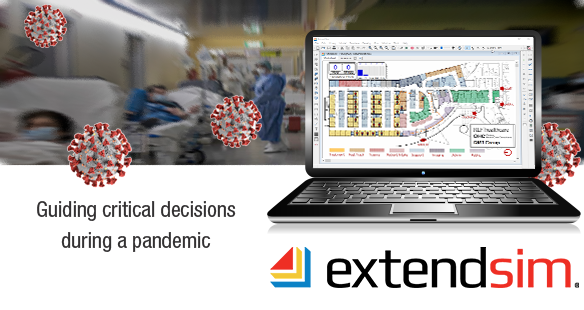


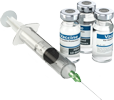


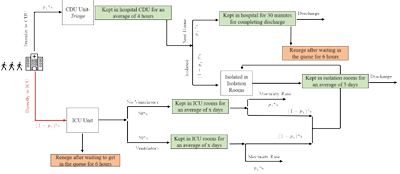
 Download Paper
Download Paper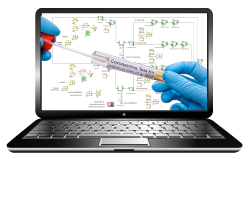

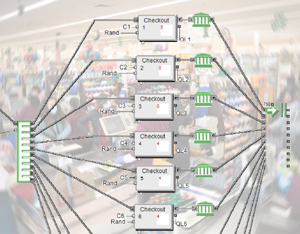

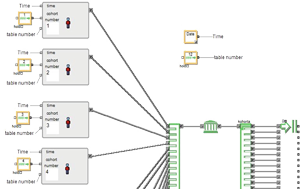

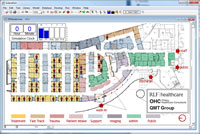
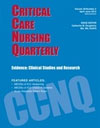
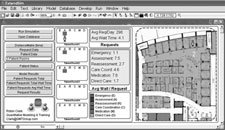
 Read Article
Read Article


